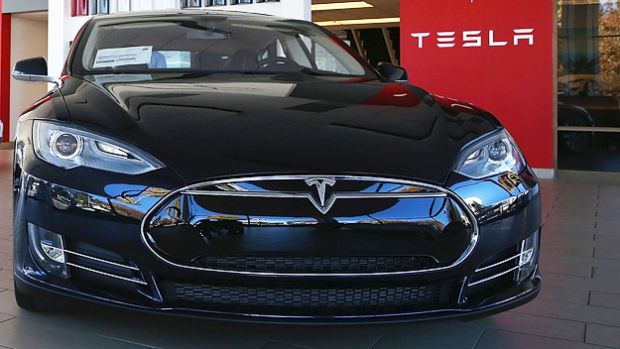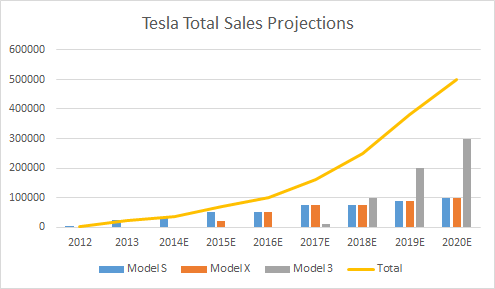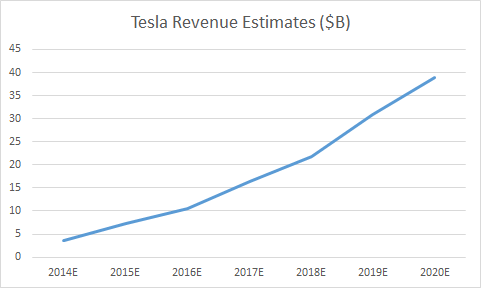Investor's Corner
Projecting Tesla’s Growth for the Next 6-10 Years

When Tesla announced its Gigafactory, it provided us with a fairly detailed picture of its growth going forward. And now that the Gigafactory deal is done with Nevada, that growth seems to be a low risk assumption. Tesla has also provided us with some color about 2015 and using all this information and filling in the blanks, I’ve come up with this chart for Tesla’s automotive growth going forward:

Tesla’s Gigafactory is expected to produce 50GWh of battery packs in 2020. If we assume that 85kWh is the average pack size – I expect the Model 3 pack to be smaller and Model X pack to be larger – Tesla will need 42.5GWh for automotive use. That leaves an excess of 7.5GWh for energy storage. By early next year, Tesla will be using as much or more than the rest of the global cylindrical cell output combined based on their stated Model S run rate goal of 50,000/year. So at 500,000 cars per year, Tesla would be using 10 times the current global output of cylindrical cells and more than the current total global output of batteries.
However, the Gigafactory should be maxed out by then and my personal prediction is that we will either see a major expansion of the Gigafactory go online shortly after 2020 or we will see more such factories go online in the coming years. Considering that the current Gigafactory that expects to start production in 2017 broke ground in 2014, factory 2 should break ground in 2018, just after the first one goes online. My expectation is also that during that time frame at the latest, Tesla will start considering auto factories on other continents.
Tesla has also stated that they are building superchargers at a rate greater than one per day. At that rate, by 2020, Tesla will have 2000 superchargers globally, enough to give them a major leg up over any other manufacturer. In fact, by 2017, which is the earliest that any long range EVs are expected, Tesla should already have 1000 supercharger stations in place. That would already put the Model 3 ahead of any potential competition in the space.
As far as storage batteries go, Tesla currently sells some storage batteries through SolarCity both for residential and commercial customers. Currently this is a very small limited availability offering. However, the Gigafactory will change all that making batteries more affordable and giving SolarCity the ability for bigger and more widespread deployments. As someone with solar panels, this excites me as much or more than automotive growth for Tesla. As solar system prices are dropping, over the next decade storage along with panels might become the norm. The market for this is potentially limitless.
So if you think that you have missed out on Tesla’s growth, you are wrong. Major growth is still to come. If there is one company I see becoming bigger than Apple, it is Tesla. Here is what Tesla’s revenue growth would look like with Model S average price of 100,000$, Model X at 110,000$ and Model 3 at 60,000$ from cars alone.

At 500,000 cars, Tesla will have 0.5% of the global auto market still leaving significant growth potential ahead. Even though there has been a recent up tick in rumors of 200 mile EVs, I expect none of them to be competitive with Tesla until at least 2020 and that too only if the rest of the industry bothers with a charging network to enable long distance travel in an EV.
My personal estimate is that Tesla will produce 2 million cars by 2024. At that time, I estimate Tesla auto revenues of $160 billion – about equaling current GM revenues. However, none of this takes into account Tesla’s storage revenues. If by 2024, Tesla can sell 100GWh of storage batteries at 150$/kWh, that would bring in another $15 billion in revenue but at a higher margin than the auto business. At $175B in revenue and growing, with margins of 15% and a P/E of 20, Tesla would be worth more than $500 billion then. Tesla will still be a growth company with 4-6 available models and more coming soon.
Disclosure: I am long TSLA, SCTY.
Visit my personal finance blog or visit me at Seeking Alpha.

Investor's Corner
Tesla stock closes at all-time high on heels of Robotaxi progress

Tesla stock (NASDAQ: TSLA) closed at an all-time high on Tuesday, jumping over 3 percent during the day and finishing at $489.88.
The price beats the previous record close, which was $479.86.
Shares have had a crazy year, dipping more than 40 percent from the start of the year. The stock then started to recover once again around late April, when its price started to climb back up from the low $200 level.
This week, Tesla started to climb toward its highest levels ever, as it was revealed on Sunday that the company was testing driverless Robotaxis in Austin. The spike in value pushed the company’s valuation to $1.63 trillion.
Tesla Robotaxi goes driverless as Musk confirms Safety Monitor removal testing
It is the seventh-most valuable company on the market currently, trailing Nvidia, Apple, Alphabet (Google), Microsoft, Amazon, and Meta.
Shares closed up $14.57 today, up over 3 percent.
The stock has gone through a lot this year, as previously mentioned. Shares tumbled in Q1 due to CEO Elon Musk’s involvement with the Department of Government Efficiency (DOGE), which pulled his attention away from his companies and left a major overhang on their valuations.
However, things started to rebound halfway through the year, and as the government started to phase out the $7,500 tax credit, demand spiked as consumers tried to take advantage of it.
Q3 deliveries were the highest in company history, and Tesla responded to the loss of the tax credit with the launch of the Model 3 and Model Y Standard.
Additionally, analysts have announced high expectations this week for the company on Wall Street as Robotaxi continues to be the focus. With autonomy within Tesla’s sights, things are moving in the direction of Robotaxi being a major catalyst for growth on the Street in the coming year.
Elon Musk
Tesla needs to come through on this one Robotaxi metric, analyst says
“We think the key focus from here will be how fast Tesla can scale driverless operations (including if Tesla’s approach to software/hardware allows it to scale significantly faster than competitors, as the company has argued), and on profitability.”

Tesla needs to come through on this one Robotaxi metric, Mark Delaney of Goldman Sachs says.
Tesla is in the process of rolling out its Robotaxi platform to areas outside of Austin and the California Bay Area. It has plans to launch in five additional cities, including Houston, Dallas, Miami, Las Vegas, and Phoenix.
However, the company’s expansion is not what the focus needs to be, according to Delaney. It’s the speed of deployment.
The analyst said:
“We think the key focus from here will be how fast Tesla can scale driverless operations (including if Tesla’s approach to software/hardware allows it to scale significantly faster than competitors, as the company has argued), and on profitability.”
Profitability will come as the Robotaxi fleet expands. Making that money will be dependent on when Tesla can initiate rides in more areas, giving more customers access to the program.
There are some additional things that the company needs to make happen ahead of the major Robotaxi expansion, one of those things is launching driverless rides in Austin, the first city in which it launched the program.
This week, Tesla started testing driverless Robotaxi rides in Austin, as two different Model Y units were spotted with no occupants, a huge step in the company’s plans for the ride-sharing platform.
Tesla Robotaxi goes driverless as Musk confirms Safety Monitor removal testing
CEO Elon Musk has been hoping to remove Safety Monitors from Robotaxis in Austin for several months, first mentioning the plan to have them out by the end of 2025 in September. He confirmed on Sunday that Tesla had officially removed vehicle occupants and started testing truly unsupervised rides.
Although Safety Monitors in Austin have been sitting in the passenger’s seat, they have still had the ability to override things in case of an emergency. After all, the ultimate goal was safety and avoiding any accidents or injuries.
Goldman Sachs reiterated its ‘Neutral’ rating and its $400 price target. Delaney said, “Tesla is making progress with its autonomous technology,” and recent developments make it evident that this is true.
Investor's Corner
Tesla gets bold Robotaxi prediction from Wall Street firm
Last week, Andrew Percoco took over Tesla analysis for Morgan Stanley from Adam Jonas, who covered the stock for years. Percoco seems to be less optimistic and bullish on Tesla shares, while still being fair and balanced in his analysis.

Tesla (NASDAQ: TSLA) received a bold Robotaxi prediction from Morgan Stanley, which anticipates a dramatic increase in the size of the company’s autonomous ride-hailing suite in the coming years.
Last week, Andrew Percoco took over Tesla analysis for Morgan Stanley from Adam Jonas, who covered the stock for years. Percoco seems to be less optimistic and bullish on Tesla shares, while still being fair and balanced in his analysis.
Percoco dug into the Robotaxi fleet and its expansion in the coming years in his latest note, released on Tuesday. The firm expects Tesla to increase the Robotaxi fleet size to 1,000 vehicles in 2026. However, that’s small-scale compared to what they expect from Tesla in a decade.
Tesla expands Robotaxi app access once again, this time on a global scale
By 2035, Morgan Stanley believes there will be one million Robotaxis on the road across multiple cities, a major jump and a considerable fleet size. We assume this means the fleet of vehicles Tesla will operate internally, and not including passenger-owned vehicles that could be added through software updates.
He also listed three specific catalysts that investors should pay attention to, as these will represent the company being on track to achieve its Robotaxi dreams:
- Opening Robotaxi to the public without a Safety Monitor. Timing is unclear, but it appears that Tesla is getting closer by the day.
- Improvement in safety metrics without the Safety Monitor. Tesla’s ability to improve its safety metrics as it scales miles driven without the Safety Monitor is imperative as it looks to scale in new states and cities in 2026.
- Cybercab start of production, targeted for April 2026. Tesla’s Cybercab is a purpose-built vehicle (no steering wheel or pedals, only two seats) that is expected to be produced through its state-of-the-art unboxed manufacturing process, offering further cost reductions and thus accelerating adoption over time.
Robotaxi stands to be one of Tesla’s most significant revenue contributors, especially as the company plans to continue expanding its ride-hailing service across the world in the coming years.
Its current deployment strategy is controlled and conservative to avoid any drastic and potentially program-ruining incidents.
So far, the program, which is active in Austin and the California Bay Area, has been widely successful.








